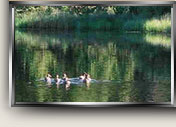Hydrology and Nitrate Loading
While the
ground surface is very dry during the summer and fall, the water
table is only about five feet below the surface through most of the
ranch. The Geotechnical Report for the Pond Area states, “the water
table tends to be reasonably stable at an elevation about 5 feet
below the meadow elevation adjacent (to) the west side of the pond. This
water table is likely to vary seasonally and in a wet year could
approach the surface. In an extended dry period the water level
could fall a bit but we suspect that 5 feet below meadow elevation
is nearly as low at the water table gets. Area groundwater moves
most efficiently through a sandy lens that tends to be 5 to 6 feet
below grade although saturated soils prevail to substantial depths
(probably many hundreds of feet).”
Soils reports for
several lots on the east side of the ranch indicate a water table of
from 4.75 feet to 10 feet below the ground surface. The variation
in depth may be due more to variations in the ground surface
elevation than to variations in the level of the water.
Measurements by
the ranch foreman in 2007 and 2008 show that the water table in the
meadow west of the pond is relatively stable throughout the year,
though it does rise when rain and snow begin in November. The
ground water level, at least in the meadow area, does not drop when
the water level in the river drops in October. See the
Ground Water Level
Measurements in the Appendices. When a sufficient volume of
snow melts in the spring, substantial surface water appears on the
river’s floodplain. There is also a low area east of Hashknife
Road, across from Lots 12 and 13, that holds water when the snow
melts.
Nitrate Loading
In 2007, a U.S.
Geographic Service study found that
nitrate levels in the area's ground water aquifer are increasing due
to contamination from residential septic systems. The contamination
has public health implications because ground water is the sole
source of drinking water for many area residents.
The U.S.
Environmental Protection Agency has established 10 parts per million
(ppm) of nitrogen as the maximum allowable nitrate concentration in
drinking water for public water supply systems. Oregon law sets a
nitrate concentration of 7 ppm as the level at which regulatory
action must be taken. While
only 10% of 200 area wells surveyed have a nitrate concentration of
over 4 ppm in 2007, the study concluded that contamination will
eventually reach unacceptable levels if the amount of nitrates put
into the ground every year (nitrate loading) is not decreased from
present levels. Deschutes County is working on programs to
require residents to equip septic tanks to remove nitrates.
From a natural
resource point of view, the concern with excessive nitrates is that
they could support the growth of algae and weeds in waterways.
But plant growth is almost always limited by a scarce supply of
phosphorus, not nitrogen or nitrates. So if nitrates increase
in the river, it is most likely that weed and algae growth will not
increase. The Little Deschutes River, and even its backwaters,
do not have a significant algae or weed problem today. A water
sample from the pond, fed by groundwater and well water, found no
detectable nitrate at all.
For more
information about nitrate loading, see the following two documents:
Evaluation of
Approaches for Managing Nitrate Loading from On-Site Wastewater
Systems near La Pine, Oregon Scientific Investigations
Continue to Climate
Return to
Stewardship Plan Table of Contents






